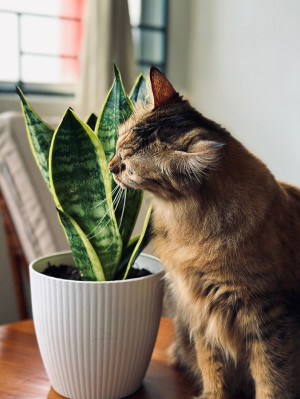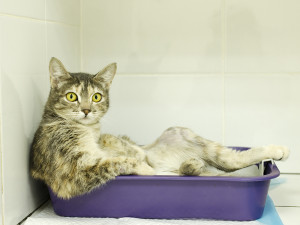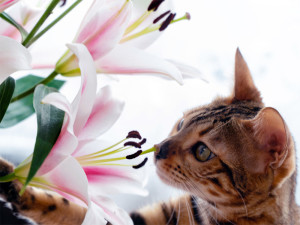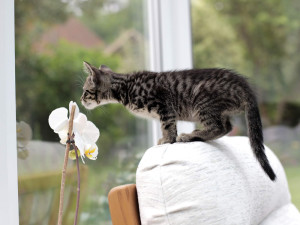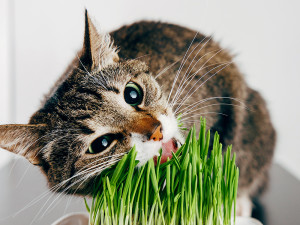Non-Toxic Flowers That Are Safe for Cats
And flowers that aren’t safe, too.

Share Article
In This Article:
Flowers That Are Toxic for Catsopens in a new tab Flowers That Are Safe for Catsopens in a new tab What to Do if a Cat Eats a Plant That Might Be Poisonousopens in a new tab Tips to Keep Your Cat Away from Plants and Flowers that Are Toxicopens in a new tab Are Roses Toxic to Cats?opens in a new tab What Are Some of the Best Flowers for Cats?opens in a new tab
It would be difficult to find a person who doesn’t love flowers. We use them in so many different ways: decoration, gifting, gardening, pressing and drying, crafting, culinary use - and the list goes on and on. However, we also love our cats, and some flowers are very toxicopens in a new tab to our favorite felines.
While you’ll probably never know the name of every last toxic flower (it’s a very long list), it’s important to be aware that toxic flowers exist and where to go to get information about them. It’s also important to learn how to keep your cats away from toxic flowers, what to do if they eat one, and which flowers are safe to use around cats.

littleKin™ is Kinship’s home just for puppy and kitten parents. Bop over to check out expert advice, new pet tools, and special deals—all curated for your newest family member.
opens in a new tabMain Takeaways
Many flowers are toxic to cats.
There are safe flowers and plants that cats actually enjoy.
Call your Vet or ASPCA Poison Control if your cat eats a toxic flower or plant.
There are ways to keep your cat away from poisonous flowers.
Flowers that are toxic for cats
The ASPCA maintains a database that contains over 700 flowers and plants that are toxic to cats. Some cause only mild gastrointestinal symptoms, while others can be deadly. Here’s a sample of some of the most common ones.
Flowers that are highly toxic to cats:
Lilies (all parts of the plant): extremely toxic to cats, even causing kidney failure.
Oleander: can cause serious GI distress and affect the heart.
Azaleas/Rhododendrons: can cause GI distress and potentially life-threatening heart disease.
Foxglove: can cause serious heart arrhythmias and death.
Daffodils: are particularly toxic and can cause severe vomiting and tremor.
Flowers that are moderately toxic to cats:
Tulips: can cause GI upset with the bulbs being the most dangerous part of the plant.
Hyacinths: can cause GI upset, including drooling.
Chrysanthemums: can cause GI upset plus dermatitis.
Amaryllis: can cause vomiting, lethargy, and tremors.
Baby’s Breath: causes mild GI upset
Carnations: causes mild vomiting and drooling
Those are only a few examples. As mentioned before, hundreds of flowers and plants are toxic to catsopens in a new tab.
Flowers that are safe for cats
Fortunately, even if we have cats, we can still give and receive flowers, engage in crafts with them, decorate our homes, and a multitude of other beautiful things. We can do those things by using flowers that are safe for catsopens in a new tab. Here’s a sample:
Roses (Rosa spp.)
Sunflowers (Helianthus spp.)
Gerbera Daisies (Gerbera jamesonii)
Snapdragons (Antirrhinum majus)
Zinnias (Zinnia spp.)
Marigolds (Calendula officinalis)
Calendula (pot marigold) is safe, but French and African marigolds should be avoided as they can cause mild irritation.
Petunias (Petunia spp.)
Orchids (Various species)
Most orchids, including Phalaenopsis (moth orchids), are safe for cats.
Asters (Aster spp.)
Celosia (Celosia spp.)
Bachelor’s Buttons (Centaurea cyanus)
Alstroemeria (Peruvian Lilies)
Unlike true lilies, Peruvian lilies are generally safe for cats but may cause mild gastrointestinal upset if consumed in large quantities.
African Violet
Roses
Pansies
Bottlebrushes
Impatiens
What to do if your cat eats a plant that might be poisonous
Time is critical, so act quickly and follow these guidelines:
1. Identify the flower. If you’re unsure what the flower is, take a picture to show your veterinarian or upload it to Poison Control.
2. Remove your cat from the area where the flowers are. If possible, remove the flowers.
3. Check for symptoms of poisoning, including:
Vomiting
Diarrhea
Drooling
Lethargy
Difficulty breathing
Tremors or seizures
Even if there are no symptoms, still consider it an emergency. Some toxins take hours to days to affect your kitty.
4. Contact your veterinarian or an animal poison control center. Some poison control hotlines include:
ASPCA Animal Poison Control Centeropens in a new tab: (888) 426-4435 (a consultation fee may apply).
Pet Poison Helplineopens in a new tab: (855) 764-7661.
Be ready to give them details such as the flower your cat ate, how much they ate, and your cat’s weight and symptoms.
5. Do not induce vomiting unless a veterinarian tells you to. Inducing vomiting at home can sometimes do more harm than good, depending on the substance ingested. Only induce vomiting if your vet tells you to.
6. Follow veterinary instructions. Your vet may ask you to bring your cat in for treatment, which may include:
IV fluids to support organ function
Medication to treat symptoms or prevent complications
Activated charcoal to bind the toxin
Medication to Induce vomiting
7. Bring the flower with you to the vet for possible identification.
Tips to keep your cats away from flowers and plants that are toxic
If you want to keep flowers and plants in your home, here are a few tips to keep your cat safe:
Choose cat-safe plants. The easiest way to keep your kitty safe is to avoid flowers in your home altogether. Otherwise, choose flowers that are not toxic to felines. See our list above.
Keep toxic plants out of reach. You can have only hanging plants, a room with a door for your plant collection, or place them on high shelves.
Create barriers. Use plant terrariums or enclosures to keep cats and flowers protected.
Use deterrents. Dab some scents around flower pots, but ensure your scents are safe for cats. Cats do not like the smell of citrus, vinegar, or certain essential oils such as rosemary and lemongrass. They also do not like aluminum foil, so if you are having problems with your kitty digging in the soil and even urinating there, cover the soil with aluminum foil.
Distract your cat with cat-safe alternatives. Have cat grass or catnip available as an alternative for your cat. They are more likely to focus on these.
Sprinkle black pepper or dry mustard powder around the base of the flower. Cats dislike the smell and taste.
Provide enrichment to minimize curiosity. Cats often explore plants out of boredom. Provide toys, scratching posts, and playtime to keep your cat entertained and less likely to mess with plants.
Train your cat. Say “No!” if your cat approaches your plants and redirect their attention to toys or activities. Reward them when they obey.
If you receive a bouquet containing toxic flowers, keep it out of your cat’s reach.
Are roses toxic to cats?
Roses are not toxic to cats. However, there are a few important points to keep in mind:
The thorns on roses can pose a physical hazard if a cat chews on or swallows parts of a stem with thorns.
Roses treated with pesticides, fertilizers, or other chemicals might be poisonous if ingested.
Some plants that are called “roses” (the Christmas rose, Helleborus niger, or “desert rose” Adenium obesum) are toxic to cats. Always verify the specific type of plant in question.
Roses are generally safe for cats, but keeping them away from your cat is a good idea. If there’s any chance your cat has eaten part of a rose plant and is showing symptoms of toxicity, call your vet.
What are some of the best flowers for cats?
Some flowers and plants are not only safe, but are attractive to cats, include:
Catnip (Nepeta cataria): Cats love this plant for its stimulating effects, and the flowers are safe to chew on.
Valerian (Valeriana officinalis): Known for its calming effects on humans, valerian flowers can be a treat for cats (similar to catnip).
Cat thyme (Teucrium maru): This slow-grower is another feline stimulant and is often effective with cats for which catnip has no impact.
Lavender: While the plant is safe in small amounts, cats usually avoid it due to its strong scent.
German chamomile: German chamomile is safe and soothing, but avoid Roman chamomile, which can cause mild reactions.
Licorice root: Cats like the taste, and it’s good for their health because it is an anti-inflammatory.
Cat grass: Cat grassopens in a new tab comes in many varieties, including wheat, oat, and barley grasses. It is not a stimulant, but cats like to nibble on it occasionally.
Lemongrass: This is a mild stimulant that is appealing to cats.
We don’t know precisely why cats like to inspect our flowers and plants. It may be a craving for fiber, a sign of boredom, or just an appealing scent. If you really want flowers and plants in your home, avoid the toxic ones, of course, and try some of the cat-friendly specimens.
References
Fitzgerald, Kevin T. “Lily Toxicity in the Cat.” Topics in Companion Animal Medicine, vol. 25, no. 4, 1 Nov. 2010, pp. 213–217, www.ncbi.nlm.nih.gov/pubmed/21147474, https://doi.org/10.1053/j.tcam.2010.09.006opens in a new tab.
Milewski, Lynn M., and Safdar A. Khan. “An Overview of Potentially Life-Threatening Poisonous Plants in Dogs and Cats.” Journal of Veterinary Emergency and Critical Care, vol. 16, no. 1, 7 Mar. 2006, pp. 25–33, https://doi.org/10.1111/j.1476-4431.2005.00151.xopens in a new tab.
Mount, Michael. “Nature’s Toxic Beauties.” The North American Veterinary Conference - 2004 Proceedings, p. 1199. 1204, www.cabidigitallibrary.org/doi/pdf/10.5555/20043120467opens in a new tab.
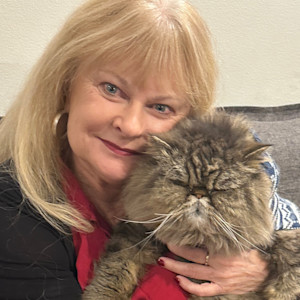
Shelby Neely
Dr. Shelby Neely is a freelance writer and veterinarian who graduated from The University of Pennsylvania and has practiced veterinary medicine for 30 years. She has found homes for hundreds of stray pets and has two cats as well as four grand-dogs and two grand-cats. In her spare time, Dr. Neely likes to be with her three children, their dogs and cats, and her own two cats. She also likes to see as many Broadway shows as possible.
Related articles
![Cute Bengal cat sniffs lilly flowers.]() opens in a new tab
opens in a new tabAre Lilies Toxic to Cats?
This holiday weekend, keep those Easter lilies far away from your kitty.
- opens in a new tab
Are Poinsettias Toxic to My Cat?
Maybe skip this holiday decoration if you’ve got a cat in the house—here’s why.
![Half-bengal kitten indoors smelling white orchid flowers in a conservatory.]() opens in a new tab
opens in a new tabAre Orchids Toxic to Cats?
Find out whether you can get that elaborate flower arrangement—or if you should skip it.
![Cat chewing on cat grass]() opens in a new tab
opens in a new tabThe 10 Best Non-Toxic House Plants for Cats
Cats love the crunch of a houseplant. These will do them no harm.
![Closeup portrait of calico cat sitting on home kitchen room table by pink rose flowers in vase, windows with blinds.]() opens in a new tab
opens in a new tabAre Roses Toxic to Cats?
They sure do like sniffing around those bouquets...
- opens in a new tab
What Flowers Are Toxic to Cats?
Find out what you can and can’t plant in your garden.
